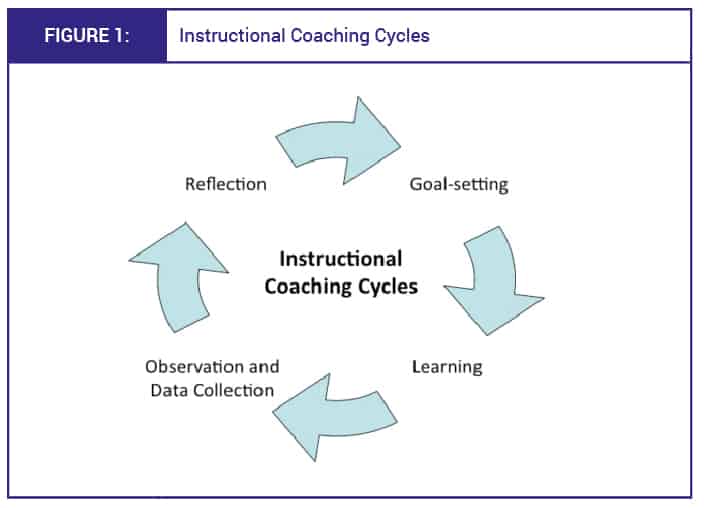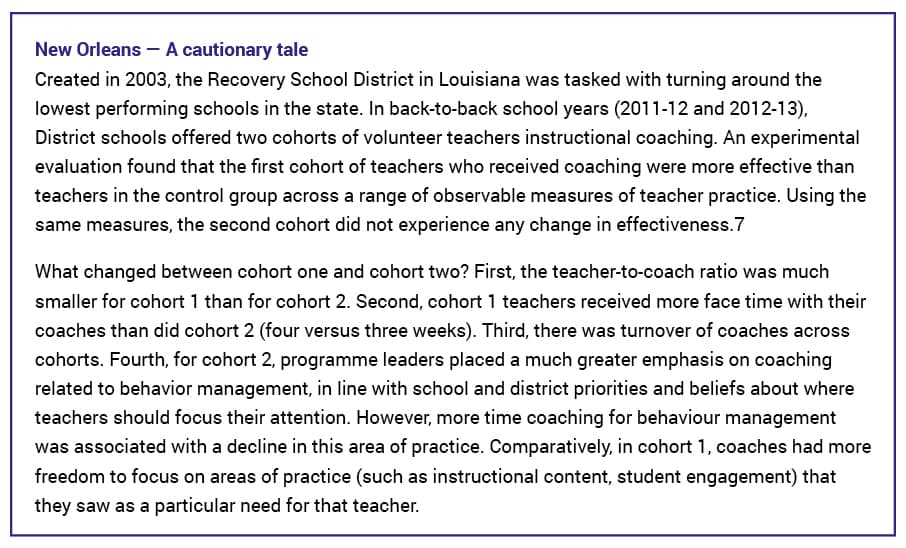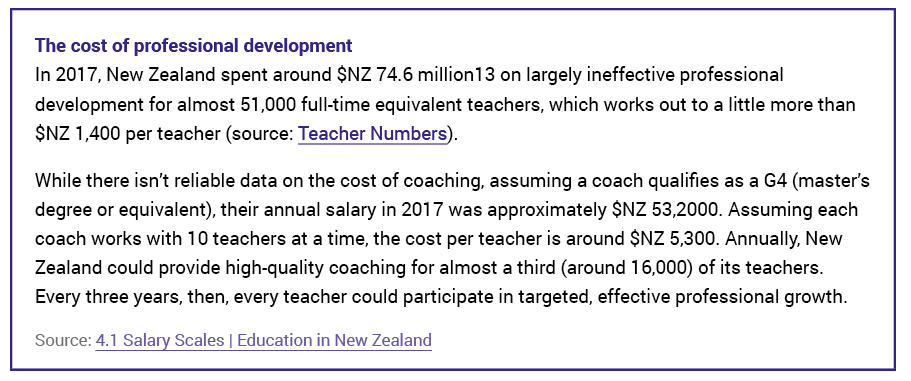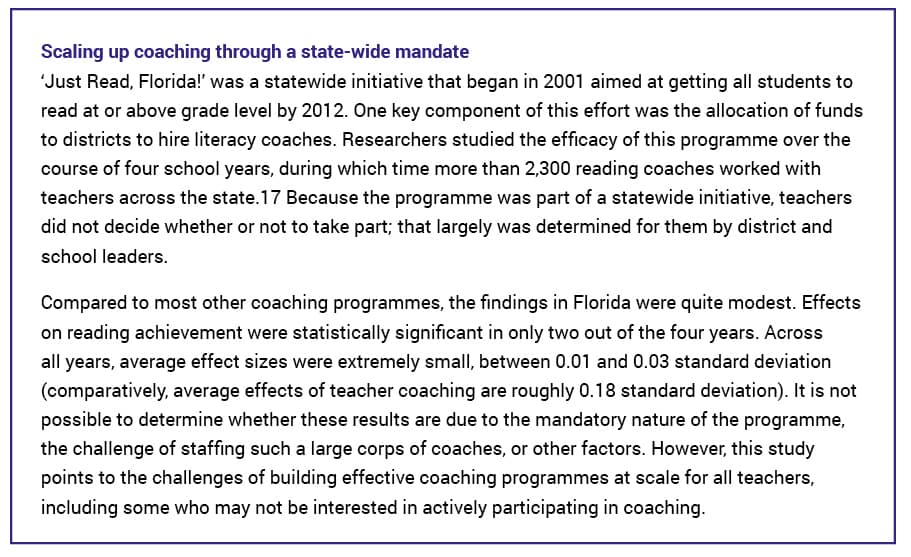In recent years, instructional coaching has become an attractive alternative to more generic teacher professional development. This research review provides an overview of what coaching is and how it works, why coaching is effective, and some considerations for school leaders as they incorporate coaching into their professional learning and development systems.
What is instructional coaching and how does it work?
Coaching is an alternative to traditional one-size-fits-all professional development. Instructional coaches work one-to-one with teachers to provide timely, relevant feedback and suggestions for improvement based on classroom observations. Coaching is differentiated to each teacher’s needs, focused on improving discrete skills, context specific, time intensive, and sustained over the course of a term or school year.
Coaching programmes can take different forms, but they tend to follow a cycle of learning, observation and data collection, reflection, and goal-setting (see Figure 1). Coaches and teachers can begin working together at any point of the cycle. Importantly, observation and feedback cycles led by coaches aim to foster teachers’ continued growth, rather than to formally evaluate teachers.

The key features of instructional coaching described above (such as being context specific, time intensive, sustained) stand in contrast to other forms of professional development and are thought to be better aligned to adult learning processes. For example, in the United States, over 99% of public school teachers report participating in some form of ongoing professional learning.[i] However, programming often takes the form of school-wide workshops, to which teachers do not respond favourably.[ii] As short-term, generalised training, these workshops rarely improve the classroom practices with which teachers need support and which benefit students in turn.[iii]
In New Zealand, leading experts and the Ministry of Education have also recognised a need to overhaul teacher professional development. Instead of allowing teachers and schools to engage in activities that are very broad in scope, development offerings are now guided by a model where engaged parties must continually assess whether professional learning activities directly align with their individual needs and those of their students.[iv] Rigorous, often experimental research shows that, not only is instructional coaching more effective than alternative forms of professional development[v], it is also one of the most effective of all educational interventions. Only high-dosage tutoring for students achieves larger effects.[vi] Notably, the logic underlying tutoring and coaching is similar: provide targeted feedback to support individuals’ needs
Why is coaching effective?
Teaching is a complex craft, and teachers are simultaneously curriculum developers, content experts, pedagogues, social workers, psychologists, mentors and motivators. Rarely is the same person equally adept at each of these roles. Coaching is likely to be effective because it is purposefully differentiated. Much like effective teaching to students, effective coaching purposefully targets each individual teacher’s needs. Coaching is also flexible. As teachers identify new areas of concern, coaches can provide feedback addressing those areas. Unlike traditional one-size-fits-all professional development, coaching can specifically build individual teachers’ capacity for using discrete instructional practices that teachers themselves, coaches, or school leaders have identified as priorities.
There may be other components or mechanisms driving the efficacy of coaching as a development tool (such as intensity or dosage). However, theory and empirical evidence suggest that the differentiated nature of instructional coaching is particularly important, and so also leads to several critical lessons and considerations for school leaders.
Considerations for school leaders
While the evidence on the effectiveness of instructional coaching is convincing, effective adoption and implementation of coaching cycles is not necessarily a linear path. This is particularly relevant as coaching programmes are taken to scale across whole schools. As such, school leaders should consider at least four key points:
- Consideration #1: Differentiation versus prescription. At its core, instructional coaching requires one-on-one work between a coach and a teacher, aimed at improving the individual needs of that teacher. However, coaching must also fit within broader instructional improvement efforts, which often are driven by school leaders. How can coaching, on one hand, be fully embedded within that top-down system and, on the other hand, maintain its differentiated focus? While school leaders may want to partially structure priority areas, evidence suggests that overriding the individual needs of teachers may lead to less effective programming.

How, then, can leaders strike that balance between differentiation and system-wide priorities? School leaders may offer a menu of priority areas for coaches and teachers to work on. School leaders may also require coaches to align their work with instructional domains found within the school system’s observation instruments or the system’s curriculum. By doing this, leaders can still structure the coaching without being too prescriptive.
Similarly, school leaders will need to consider where and when coaching is the appropriate tool for improving a given area of practice. The research literature provides strong evidence that coaching focused on early literacy and teacher-student relationships generates large improvements in teacher practice and student outcomes. If these areas of practice are a priority area for a school or system, then coaching likely will be a useful tool to achieve that goal. However, the evidence base is not as strong for other instructional domains, including mathematics[viii], which may also be a priority area. One reason for this may be that coaching is best set up to change teacher behaviours, whereas effective mathematics teaching often relies on precise, error-free delivery of content. Building strong content knowledge may be facilitated by curriculum-aligned coaching, but may also require other development efforts. Striking a balance between differentiation and prescription, bottom-up versus top-down implementation will be a challenge that school leaders will need to navigate individually.
- Consideration #2: Finding the right coach. To scale up coaching programmes, schools need to consider how to find the right coach. There is some initial evidence that coaches themselves are a critical resource, if not theprimary resource driving coaching efficacy[ix], which makes sense given the individualised nature of one-on-one coaching. In other words, coaches are the intervention. This means that leaders will need to be very thoughtful about how they recruit, train, and retain coaches. While the empirical evidence from the instructional coaching literature does not provide definitive guidance around the key characteristics of effective coaches, theory and some descriptive evidence suggest that effective coaches:
- Have strong pedagogical knowledge and skills
- Foster interpersonal relationships with teachers
- Use specific tools/strategies with teachers, such as debriefing walk-throughs, providing opportunities to practise specific teaching skills, lesson plan analysis, and so on[x]
The literature on corporate (rather than instructional) coaches, provides additional insight,[xi] pointing to the benefit of coaches who:
- Focus on goal setting
- Ensure confidentiality and are honest
- Have prior experience with coaching
- Have the ‘right fit’ in terms of personality and values with the coachee
- Are empathetic to the coachee’s concerns
- Are organised and communicate clearly
- Are self-confident
Knowing which traits effective coaches should possess is one thing. Finding (or training) individuals with these skills is another. Leaders will need to develop screening and hiring tools aligned to these characteristics.
The need to build a large corps of skilled coaches also raises the question of where to recruit these individuals, and whether recruiting coaches from current classroom positions may be beneficial or detrimental. Effective coaches may or may not be the same individuals who are highly effective with students. It is likely that there is overlap here. However, the needs of adult learners are different from those of students[xii], and so the dispositions and teaching strategies that are most beneficial for coaches to employ may or may not be the same as those that teachers employ with students.
If the overlap between effective teachers and effective coaching is large, then leaders will be faced with another tradeoff: between the benefits that come from keeping a highly effective teacher in a classroom versus using that teacher as a coach to diffuse their effectiveness across a number of classrooms. Descriptive evidence suggests the benefits of the diffusion approach, though more direct evidence on this topic is necessary. There may also be ways to ensure that coaches retain at least part of their one-on-one work with students. Video-based technology and remote coaching also could facilitate dual roles as coach and teacher, with observation of classes during off-teaching times (more on this below).
- Consideration #3: Cost. A third consideration is that coaching is costly. Whereas traditional, workshop-based professional development relies on economies of scale, one-on-one coaching does not, but to water down the one-on-one component would be to lose the benefits of coaching altogether.

The costs of coaching programmes are driven primarily by the salaries of coaches themselves. Thus, schools that are looking to make coaching a scaled and sustainable endeavour need to consider other ways to ensure that the high cost of coaching fits within budget constraints. There are at least three possible avenues for doing so:
First, as school systems move toward a coaching model, they should develop criteria to identify which teachers need coaching and which may not (or not as much). It is impractical and likely unnecessary for all teachers to receive coaching. Identifying whichteachers require coaching (and when) could be one approach to lower costs. Two potential sources of data could help make these decisions. Leaders could use diagnostic observations, which may provide the best look at who needs coaching and instructional support. A benefit of diagnostic observations is that they can also provide information on specific areas of practice where teachers need support, which could help pair teachers with a coach who excels in that area. However, observations are timely and expensive. Alternatively, school leaders could use student achievement data. These measures have been controversial in high-stakes settings,[xiv] but their use is potentially less controversial in a low-stakes setting and for resource allocation purposes.
A second way to reduce the overall costs of coaching may be to consider the frequency of coaching. How often and for how long will the coach meet with their teachers? There is some evidence that quality is more important than quantity.[xv] Relatedly, leaders could consider under what conditions to deviate from the one-to-one model of coaching. In general, the coach-teacher relationship is one-to-one. However, in some cases, if a group of teachers have identified the same growth area, the coach could perhaps meet with them collectively, for at least part of the coaching cycle (see Figure 1). Coaches would still need to observe individual teachers, but the debrief and reflection process could be in a group setting.
Drawing on video-based technology could be a third way to mitigate costs. Videotaping lessons to share with coaches is now feasible through several types of recording devices, including iPads or other tablets, Swivl devices, and phones. This approach cuts down on commuting time, allowing coaches to engage with more teachers in a given day and outside of regularly scheduled classes. Current evidence suggests that virtual coaching is as effective as in-person coaching.[xvi]
- Consideration #4: Buy-in. The key reason to scale up coaching models is the rigorous evidence base, largely drawing from randomised control trials that show very large impacts on teacher practice and student outcomes. However, randomised trials usually rely on volunteers, who presumably already believe coaching will be helpful. There has been little research done on coaching when it has been mandatory.

Thus, leaders should carefully consider whether or not to make coaching mandatory. Leaders may start first by seeking to build a culture of continuous improvement, whereby teachers are open to identifying their own strengths and weaknesses as teachers and want to engage in the hard work of improving their practice. At a minimum, leaders need to make clear that evaluation and coaching serve different purposes (and so, also require having different staff lead these efforts). School leaders also will need to put in the hard work of gaining teacher buy-in and fostering a culture of continuous improvement.
Introducing a formal career ladder (from teacher to coach) may be one way to do so. That is, by embedding coaching with school systems, not only do teachers have an opportunity to improve their practice but also have an opportunity for increased job responsibilities (and possibly increased pay) if they too become a coach to other teachers. There likely are other ways to build buy-in, which schools and leaders should consider based on the culture of their own contexts.
Endnotes
[i] Goldring, R., Gray, L., Bitterman, A., & Broughman, S. (2013). Characteristics of public and private elementary and secondary school teachers in the United States. Washington, DC: National Center for Education Statistics.
[ii] Farkas, S., Johnson, J., & Duffett, A. (2003). Stand by me: What teachers really think about unions, merit pay, and other professional matters. New York, NY: Public Agenda.
[iii] Reviews of teacher professional development show that most programmes fail to improve teacher knowledge, teacher practice, or student achievement. For one review, see: Yoon, K. S., Duncan, T., Lee, S. W. Y., Scarloss, B., & Shapley, K. L. (2007). Reviewing the evidence on how teacher professional development affects student achievement. Issues & Answers. REL 2007-No. 033. Regional Educational Laboratory Southwest (NJ1).
[iv] Professional Development Advisory Group. (2014). Report of the professional learning and development advisory group. Retrieved from: http://www.education.govt.nz/assets/Documents/Ministry/Initiatives/PLDAdvisoryGroupReport.pdf
[v] More recently, Kraft, Blazar, and Hogan (2018) conducted a meta-analysis of the causal evidence of teacher coaching programmes specifically (a subset of professional development programmes), and found average effects on teachers’ instructional practice of roughly 0.5 SD and on student achievement of roughly 0.2 SD. Of the 60 studies included in the analyses, 56 were randomized control trials. Kraft, M. A., Blazar, D., & Hogan, D. (2018). The effect of teacher coaching on instruction and achievement: A meta-analysis of the causal evidence. Review of Educational Research, 88(4), 547-588.
[vi] Fryer (2017) conducted meta-analyses of 196 educational experiments conducted in developed countries, and found the largest effects of one-on-one, high-dosage tutoring for students of between 0.2 and 0.4 SD in math and reading achievement. Fryer found smaller average effects of teacher professional development; that study did not disaggregate findings specifically for teacher coaching programmes. Fryer Jr, R. G. (2017). The production of human capital in developed countries: Evidence from 196 randomized field experiments. In Handbook of economic field experiments (Vol. 2, pp. 95-322). North-Holland. These effects are equivalent to or greater than a year of learning for upper-elementary and middle school students. Hill, C. J., Bloom, H. S., Black, A. R., & Lipsey, M. W. (2008). Empirical benchmarks for interpreting effect sizes in research. Child Development Perspectives, 2(3), 172-177.
[vii] Blazar, D., & Kraft, M. A. (2015). Exploring mechanisms of effective teacher coaching: A tale of two cohorts from a randomized experiment. Educational Evaluation and Policy Analysis, 37(4), 542-566.
[viii] Overall, fewer studies have evaluated the efficacy of math- and science-based coaching programmes. Kraft et al. (2018) identified two studies focused on math, and three focused on science. Some of these programmes found positive effects. However, a recent experimental evaluation of a coaching programme focused on conceptually based mathematics instruction found null effects on student achievement. Kraft, M. A., & Hill, H. C. (2019). Developing Ambitious Mathematics Instruction through Web-Based Coaching: A Randomized Field Trial. EdWorkingPaper No. 19-119. Annenberg Institute for School Reform at Brown University.
[ix] Blazar and Kraft (2020) experimentally evaluated a teacher coaching programme in New Orleans, and found large differences in effectiveness across cohorts. Exploratory analyses suggest that a likely factor for these differences was turnover of coaches across cohorts. Blazar, D., & Kraft, M. A. (2019). Balancing rigor, replication, and relevance: A case for multiple-cohort, longitudinal experiments. AERA Open, 5(3), 2332858419876252. To our knowledge, this is the only study to estimate coach effects. However, the findings are consistent with the teacher effectiveness literature, showing that personnel is the key driver of desired outcomes.
[x] For a discussion of the theoretical grounding of teacher coaching, see: Joyce, B. R., & Showers, B. (1981). Transfer of training: The contribution of “coaching”. Journal of Education, 163, 163–172. Joyce, B. R., & Showers, B. (1982). The coaching of teaching. Educational Leadership, 40(1), 4–10. For more recent discussion of the dimensions of coach effectiveness, see: Kraft, M. A., & Blazar, D. (2018). Taking teacher coaching to scale: Can personalized training become standard practice?. Education Next, 18(4), 68-75.
[xi] Carter, A., Blackman, A., & Hay, R. (2016). What makes a coach effective? Institute for Employment Studies.
Grant, A. M. (2014). Autonomy support, relationship satisfaction and goal focus in the coach–coachee relationship: Which best predicts coaching success? Coaching: An International Journal of Theory, Research and Practice, 7(1), 18–38.
[xii] When compared to children, adult learners, in general, are more autonomous and self-directed, have a wider array of life experiences (such as family responsibilities or work-related activities) upon which to draw, are relevancy-oriented (meaning they must see a reason for learning something), are problem-centered, and more intrinsically than extrinsically motivated. For a fuller discussion see: Falasca, M. (2011). Barriers to adult learning: Bridging the gap. Australian Journal of Adult Learning, 51(3), 583–590.
[xiii] Specifically, the New Zealand Ministry of Education announced in 2018 it would provide a total of $53 million USD for professional development, which included $47.3 million USD for general PD and $17.5 million USD (split across three years) for PD specifically for learning a digital technology curriculum. Center on International Education Benchmarking. (n.d.). New Zealand: Teacher and Principal Quality. National Center on Education and the Economy. Retrieved June 18, 2020, from http://ncee.org/3866-2/.
[xiv] Darling-Hammond, L. (2015). Can value added add value to teacher evaluation? Educational Researcher, 44(2), 132–137.
[xv] In their meta-analysis, Kraft et al. (2018) found only small, not statistically significant differences in the efficacy of coaching programmes based on dosage. However, there may be a baseline threshold, below which coaching no longer achieves desired outcomes. More research is needed here.
[xvi] Powell et al. (2010) randomly assigned teachers to receive web-based versus in-person coaching, and found no difference in efficacy. Both coaching modalities were (similarly) better than no coaching or business-as-usual development offerings. Powell, D. R., Diamond, K. E., Burchinal, M. R., & Koehler, M. J. (2010). Effects of an early literacy professional development intervention on head start teachers and children. Journal of Educational Psychology, 102(2), 299. In their meta-analysis, Kraft et al. (2018) also disaggregated findings by mode and found no difference in efficacy of programmes delivered online versus face-to-face.
[xvii] Lockwood, J. R., McCombs, J. S., & Marsh, J. (2010). Linking reading coaches and student achievement: Evidence from Florida middle schools. Educational Evaluation and Policy Analysis, 32(3), 372-388.
By David Blazar and Doug McNamara


